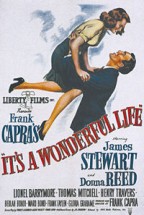I am publishing this from my archives today because I’m taking the day off!

I was really moved by Larry’s blog entry on the holiday classic, which I try to watch each year, to remind me that, despite my illness, it still is a wonderful life. You can get to his original blog post by clicking here.
Sometimes I forget — in my depression, in my financial difficulties this holiday season — that one of the most famous characters in cinematic history faced the same situation 62 years ago, Christmas 1945. In fact, he was suicidal from being threatened with jail.
Yet — with a little help from a semi-angel who hadn’t yet “earned his wings” — George Bailey, played immortally by Jimmy Stewart — was able to see that, indeed, “It’s a Wonderful Life.”
Run — do not walk, do not pass go, do not collect $200 — to the next TV showing or to your local DVD store to spend 2-1/2 (on DVD) or 3 (including commercials) hours during the holidays watching this film, my all-time favorite. ESPECIALLY if you are that proverbial only person in America who hasn’t seen it.
I’ve gotten into fights with people about whether it’s really a Christmas movie or not. Certainly the immortal director Frank Capra never intended for it to be a Christmas movie. In fact, despite the famous climax at Christmas, the movie was only given a token holiday release for the 1947 Oscars (shockingly, for now being regarded as one of the top all-time films, it didn’t win any, even for Stewart) and fully released in January 1947. Maybe that’s why its box office, while not bad, was considered disappointing (i.e., the studio was hoping for a blockbuster).
What they got instead was the first example — as happens often today with movies like the original “Austin Powers” — where most people first saw it on TV rather than in the theaters. And besides the climax, there are many explicitly Christian themes of redemption (though one might say there are Eastern themes of karma as well), so it did become a natural for TV channels to air during the holiday season. I’m willing to concede the point and focus on the movie instead.
And what a movie. First of all, the cast — besides Stewart; Donna Reed as his beloved yet resented wife; Gloria Grahame as his flirtatious friend who (and here was no Capracorn) was a woman from the wrong side of the tracks who was actually just a woman from the wrong side of the tracks; and of course, Lionel Barrymore (yes, the granduncle of Drew) as Mr. Potter.
The relationship between Mr. Potter and George was a bit like that between Javert and Valjean in “Les Miserables,” or between Salieri and Mozart in “Amadeus” — where one man saw greatness in the other, resented it, and sought to destroy it or at least neutralize it.
George, as he grew into a young man in the small upstate New York town of Bedford Falls, had ambitions of traveling the world. He quickly forgot about incidents where in his selflessness he had saved two men (and ultimately, it turned out, many more) — his brother Harry from drowning as a child; and his pharmacist, Mr. Gower, from putting the wrong medicine in someone’s prescription that would have killed his patient.
He met and fell in love with a librarian named Mary (Reed) — who, alas, was the ultimate homebody. George’s friend Sam Wainwright also wooed Mary, but even his wealth was no match for George’s charm. (“You want the moon, Mary? I’ll throw a lasso around it …”)
Still, it also fell upon George to stay in town and not go to college like his brother, and to run the family business, Bailey Building and Loan — a savings and loan run by his late father which, since it didn’t have full bank status, remained dependent on Potter’s bank.
Mary and George married at the height of the Great Depression. Mary had a dream of renovating an old decrepit mansion into a home for them in Bedford Falls. Her compromise with the restless George was that they would have an elaborate honeymoon of traveling. Suddenly, there was a bank panic. Potter offered to buy off Bailey’s customers for 50 cents on the dollar. The only way the Building and Loan would not go bankrupt, Mary realized, was to give away the honeymoon fund to its customers. And so she did. (You’ll never again forget the phrase “Mama dollar and Papa dollar.”)
Potter, impressed by George saving the business, offered to buy George out instead. George almost accepted, but then refused, realizing he couldn’t work for Potter. So he threw his former ambitions back into the Building and Loan, giving mortgages to lower-middle-class townspeople for new homes. Meanwhile, he and Mary had four kids. (And George was 4-F for World War II — he was injured saving Harry all those years ago — a fact the movie illustrates, and that I know from my own grandfather, made many men feel emasculated.)
So far, it’s a wonderful life, but it’s also an ordinary life. And that gnawed on George — though we didn’t realize how much until Christmas Eve 1945. George had to stay at the Building and Loan for a bank inspection, so George’s doddering old Uncle Billy took a huge deposit to Potter’s bank.
And lost it.
And Potter found it. And realized he had his chance to destroy the Baileys once and for all.
When George, frantic and threatened with arrest by the bank regulators, confronted Uncle Billy, he slapped him and threatened to testify against him in his anger. Then he pleaded with Mr. Potter that there had to be some mistake, so George offered his life insurance as collateral.
Potter’s immortal reply: “You’re worth more dead than alive.”
Which gave George the most horrible of ideas. And thus begins the real story.
Most of us know the images by heart, so I won’t recite them here. Suffice to say you see countless parallels between how George first encounters his semi-angel and how George saved his brother (and, it turned out, thus saved an entire World War II troop ship — his brother won the Medal of Honor for heroism); how George resented his friend Sam Wainwright for his wealth — yet they were still friends even after George had married Sam’s love Mary; how George and Mr. Potter traded the words (with some accuracy for both) “warped and frustrated” to describe each other.
And in the alternate reality that Clarence the “angel second-class” showed George … we see that what Violet Bick (Gloria Grahame’s small but critical character) was suspected by the less charitable to be in real life, she actually was in the alternate reality. That where George had built an authentic neighborhood called Bailey Park, Potter had transformed Bedford Falls into a gaudy Las Vegas-type “Potterville.” Poor Mr. Gower, of course, rotted to death in jail for manslaughter for killing his patient. Mary, fitting the stereotype, became a librarian spinster. Their house, instead of being (slowly) renovated as in real life, literally crumbled to the ground. And Uncle Billy, predictably, was institutionalized.
Some of the best scenes in the movie, though, are in the “real-life” part. When George and Mary meet at a dance and fall into a swimming pool, it was filmed at Beverly Hills High School (yes, the campus, much rebuilt, later the setting for “90210”), which had a combination gym and pool.
And the scene that still gives me chills is during that fateful Christmas Eve. George has just yelled at his daughter Zuzu’s teacher on the phone, in his anger knowing disaster is about to strike. He then storms out to his friend Martini’s tavern. (Martini, who financed his house with a Bailey Building and Loan mortgage.) There, he folds his hands on the bar and says, “Lord, I’m not a praying man,” and you see ultimate fear on Stewart’s face. (Proof that some of the best acting is wordless.) Then, he asks G-d to give him a sign. It turns out the man next to him is Zuzu’s teacher’s husband, who punches him in the face.
(That’s the karma — and sometimes, that’s how I feel in my relationship with G-d, trying to figure out what I did …)
When, with Clarence’s help, George finally realizes that he has, in fact, lived the ultimate life of “Six Degrees of Separation” (eat your heart out, Will Smith, Donald Sutherland, Stockard Channing and John Guare), his celebration — redemption, really — is joyous. “I’m going to jail — MERRY CHRISTMAS!” he yells jubilantly while running through Bedford Falls, realizing that being alive, even if in disgrace, is its own prize.
Of course, we know that Frank Capra would never let George Bailey go to jail to end the movie. (Hint: Remember, George has a very rich friend.) And, yes, that closing scene with everyone at the Baileys’ house (including Harry just home from the war) singing “Auld Lang Syne” as Zuzu says, “My teacher says every time a bell rings, an angel gets its wings” — as the Bedford Falls town bell rings — is probably the most schmaltzy end to a movie in American history.
(And inspired endless jokes, after the land speculation craze of the early 1980s forced the government to shut down all savings and loans, that George Bailey was the first “S&L crook.”)
But still, remember what the last scene does not do. It doesn’t expose Uncle Billy as the one who caused the crisis (to anyone besides George and Mr. Potter, of course), and it doesn’t punish Mr. Potter. (That was left to the delicious Saturday Night Live parody, “The Lost Ending of ‘It’s a Wonderful Life,'” with Dana Carvey as George, the late Phil Hartman as Uncle Billy and Jon Lovitz as Mr. Potter, which ends — after Uncle Billy remembers that Mr. Potter took the money — with George’s friends becoming a lynch mob looting Mr. Potter’s home and George going medieval on Potter himself with Potter’s own cane.)
The grace (if perhaps overdone) with which Capra ended the movie — no retribution, no justice in the ultimate sense, just recognition that a good man in trouble desperately needed and deserved help, and got a little from above — is a lesson I need to learn, over and over and over. That there is no ultimate justice in this world (contrary to Saturday Night Live); and we must depend on grace to get us through to the next one.
Therese Borchard of Beliefnet’s Beyond Blue blog is a massive fan of the Holly Hunter show on TNT “Saving Grace,” which might be called a raw, modern update of the themes of Stewart and Capra’s classic.
But I’m a traditionalist when it comes to these things, and “It’s a Wonderful Life” is where I find saving grace in this Christmas season.
